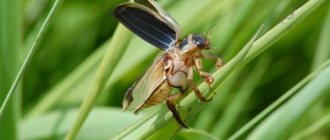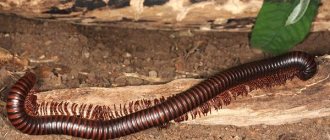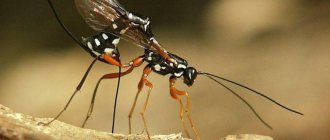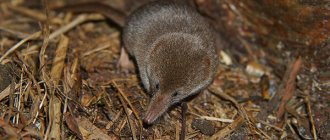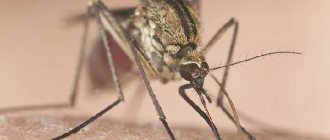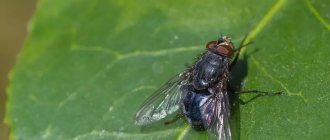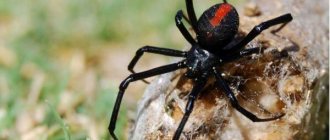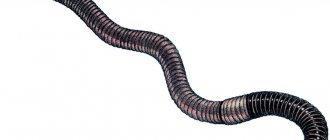Description and features
The bombardier beetle is an insect 5-15 mm long. The appearance and proportions are typical of ground beetles, to which it belongs. The body of an adult insect is elongated and oval. The general color is dark with a metallic sheen; individual parts of the body are often painted in red-brown tones.
The head is weakly retracted into the prothorax, located mainly horizontally, with a slight downward tilt. It ends in small sickle-shaped mandibles, adapted for holding and tearing victims - other smaller insects. The labial palps consist of 3 segments.
The eyes are medium in size and correspond to a predominantly gloomy lifestyle. There is one supraorbital seta at the edge of the eyes. There are no additional eyes. Beetles belonging to the subfamily Brachininae have 11-segmented filamentous antennae.
The first segment contains a seta; several similar bristle-hairs can be seen on the last segment of the antennae. Insects from the subfamily Paussinae have spectacular feathery antennae. The head and pronotum, antennae and limbs are usually dark red.
The legs are long, adapted for walking on hard ground. The structure of the limbs is complex. Each consists of 5 parts. By their type they are classified as running. There is a peculiarity on the forelimbs: on the lower legs there is a notch - a device for cleaning the antennae.
The elytra are hard, usually covering the body of the beetle completely, but in some species they are shorter than the body. Their ends come in three types: rounded, “cut” perpendicular to the center line of the body, or beveled inward. The beetle's elytra are colored blue, green, and sometimes black. They have longitudinal shallow grooves.
The wings are moderately developed, with a network of caraboid veins. Bombers rely more on their legs than their wings. They flee from enemies and use flights to explore new territories. Insects belonging to some closed populations, mostly island ones, have completely abandoned flight.
The insect's abdomen consists of 8 sternites, dense sections of segmental rings. Males and females are similar in appearance. Males have additional segments on their tarsi that are designed to hold females during copulation.
The most famous of the bombardiers are the codfish, who live in Europe and Asia, in Siberia to Lake Baikal. In the north, the beetles' range ends in the subpolar tundra. In the south it reaches deserts and scorched dry steppes. The bombardier beetle lives not only on flat terrain; it can be found in the mountains, but they do not reach the zone of eternal snow.
In general, beetles prefer places with dry to moderately moist soil. They are nocturnal. During the day they hide under stones and other shelters, and at dusk and at night they begin to feed. The peak activity of bombardiers occurs during sunset hours. They prefer this time not only for searching for food, but also for settling.
The ability to fly is demonstrated mainly by young insects that have just emerged from the pupa. The instinct to explore new territories kicks in. In the future, the bombardiers' passion for flying fades away.
Bombardier beetles are part of the ground beetle family and look very similar to them
As winter approaches and the days shorten, insect activity decreases. With cold weather, beetles fall into a kind of hibernation, they enter diapause, during which metabolic processes in the body decrease almost to zero. In a similar way, the body of beetles can react to summer drought.
Observing the life of insects, scientists found that during the day, under stones, beetles gather in groups that are not only numerous, but also heterogeneous in composition. Initially, the reason for collective recreation was considered to be a limited number of shelters.
The generic diversity of the groups suggested that the reason for grouping was security considerations. A large number of scorers on offense can be more active in defense. Under the cover of “artillery” it is easier for beetles of other varieties that do not have the capabilities of bombardiers to hide from enemies.
Sometimes bombardiers form small flocks with other beetles
A way to protect yourself from enemies
The bombardier beetle defends itself in the most original way. Its defensive system has no analogues among insects. Sensing the approach of an enemy, the beetles direct a caustic, foul-smelling, hot mixture of liquid and gas towards him.
There are two glands on the abdominal cavity - a paired firing device. The combat mixture is stored in a “disassembled” state. Two sets of chemicals are housed in two glands, each of which is divided into two compartments. One compartment (storage tank) contains hydroquinones and hydrogen peroxide, the other (reaction chamber) contains a mixture of enzymes (catalase and peroxidases).
The attack mixture is produced immediately before the shot. When a frog or ant comes into view, hydroquinones and hydrogen peroxide are squeezed out of the storage tank into the reaction chamber. Under the action of enzymes, oxygen is released from hydrogen peroxide.
To defend themselves, bombardier beetles shoot a stream of poisonous gases at the enemy.
The chemical reaction proceeds very quickly, the temperature of the mixture rises to 100°C. The pressure in the explosion chamber increases rapidly and repeatedly. The beetle fires a shot, positioning its abdomen so as to hit its enemy. The bombardier beetle in the photo shows his ability to shoot from different positions.
The walls of the chamber are covered with a protective layer - cuticle. In addition, groups of spherical unicellular enzyme glands are located along the walls. The mixture of liquid and gases escaping from the nozzle is not only hot and foul-smelling, it produces a loud sound that enhances the deterrent effect.
The directed jet is surrounded by a cloud of finely dispersed components. It contributes its share to the beetle’s defense—it disorients the aggressor. The outlet is equipped with side reflectors that turn it into a controlled nozzle. As a result, the direction of the shot depends on the position of the body and is specified using reflectors.
The range of the jet is also adjustable: the beetle produces a liquid-gas mixture with droplets of different sizes. An aerosol with large droplets flies close, while a finely dispersed mixture shoots over a long distance.
When fired, all reagent reserves are not consumed. They are enough for several emissions of caustic aerosol. After 20 shots, the supply of components runs out and the beetle needs at least half an hour to generate chemicals. Usually the beetle has this time, as a series of 10-20 hot and poisonous emissions is enough to kill or at least drive away the enemy.
At the end of the last century, entomologists identified at least one species in which the shot consists of several micro-explosions. The mixture of liquid and gas is not formed simultaneously, but consists of 70 explosive impulses. The repetition rate is 500 pulses per second, that is, 70 micro-explosions take 0.14 seconds.
This shot mechanics ensures a more gentle effect of pressure, temperature and chemistry on the body of the shooter himself - the bombardier.
According to another version, the beetle is saved from the effects of its own weapons by the fact that the explosion occurs outside its body. The reagents do not have time to react, they are thrown out, at the exit from the insect’s abdomen they mix and at this moment an explosion occurs, creating a hot, harmful aerosol.
Life cycle
The bombardier beetle is similar to all other members of the family Carabidae in that it undergoes complete metamorphosis. The eggs are often laid in a safe location, protected from predators, such as a pile of dirt or dead, decaying plants. After the larva hatches from the egg, it immediately begins a pattern of food consumption and [[molting]]. After stopping the last shedding of its exoskeleton, the larva becomes a pupa, where it continues a similar process as the larval stage. After the final molt of the pupa, the insect becomes an adult [8][6].
Members of the family Carabidae have an average lifespan of several weeks. During this period of time, the bombardier undergoes a metamorphosis from egg to adult. Beetles also have the opportunity to mate during this time. Bombardier beetles are of each genus and go through a similar life cycle that may vary slightly depending on their habitat. [6]
Kinds
The bombardier beetle is an insect belonging to two subfamilies: Brachininae and Paussinae. They, in turn, belong to the ground beetle family. Many scientists believe that both branches develop independently. Others suggest that the subfamilies shared a common ancestor.
The discussion about the possibility of independent emergence and development of the same protective mechanism goes beyond the scope of problems of biological systematics and sometimes acquires a philosophical meaning. The subfamily Paussinae is distinguished by the structure of its whiskers. In addition, these insects often choose anthills as a home, that is, they are myrmecophiles.
The beetles included in this subfamily have been little studied. Coleoptera from the subfamily Brachininae are better known and studied. It includes 14 genera. Brachinus is the first genus of bombardier beetles described and included in the biological classifier. The genus includes the species Brachinus crepitans or crackling bombardier.
This is a nomenclatural species; the description and name of the entire genus (taxon) are based on data about it. In addition to the codfish bombardier, the genus Brachinus includes another 300 species, 20 of which live in Russia and neighboring countries. Other types of bombardiers can be found everywhere, except in areas with harsh climates.
Despite the presence of wings, bombardiers prefer to move on the ground
Ecology
Range map showing the location of bombardier beetles of the genus Brachinus
Various species of bombardier beetles can be located on all continents except Antarctica (the range map shows only bombardier beetles of the genus Brachinus and therefore lacks the location of species from the subfamily paussinae). The species Brachinus fumans lives only in North America while Brachinus crepitans lives in various parts of Europe including central Sweden, southern England, and south Wales, as well as parts of northern Africa. [6] Brachinus crepitans mainly lives in coastal areas, but they have been seen in inland areas. [3] Most bombardier beetles prefer to live in temperate [[forests]] or [[grasslands]], but Brachinus fumans lives in deserts, savannas, chaparral and forests. [6] Although many species prefer these conditions, bombardier beetles vary considerably in habitat settings.
Like other members of the family Carabidae, bombardier beetles are [[carnivores]] and feed on [[insects]]. In its adult stage, the bombardier beetle typically hunts either on the ground or in trees. Even in the larval stage, beetles consume other insects to provide energy for growth. [5] Bombardier beetles are rarely hunted due to their defense mechanism (see defense mechanism). This defense mechanism often repels [[predators]] who try to move too close to the beetle. [9]
Nutrition
Bombardier beetles are carnivorous insects in all phases of their existence. The larvae lead a parasitic lifestyle from the moment they are born until pupation. They eat the protein-rich pupae of other beetles.
As adults, bombardiers collect food debris on the ground surface, under stones and snags. In addition, beetles actively exterminate their smaller counterparts. They eat larvae and pupae of any arthropods that the bombardier can handle.
Reproduction
After mating, the female begins to roll small balls out of the ground in which she lays eggs (one soil lump is designed for one egg). Such similarity of spheres will serve as a refuge for the development of larvae.
The process of pupation of hatched larvae is also of interest. Since ground beetles are predators, their larvae also lead a parasitic lifestyle. For nutrition and growth, young offspring use the pupae of other insects, eating their insides. In most cases, mole crickets suffer from this. The empty chitinous cocoon of the bombardier larvae is used as a new home, where, as a result of metamorphosis, they turn into a pupa, and then into an adult. The life expectancy of a bombardier is no more than two weeks.
Reproduction and lifespan
In the spring, beetles lay eggs in the upper layers of the soil. Sometimes an egg chamber is built from mud. The female’s task is to protect the clutch from freezing. The eggs are oval in shape, with a long diameter of 0.88 mm and a short diameter of 0.39 mm. The shell of the embryos is white, translucent.
Incubation lasts several days. White larvae emerge from the eggs. After 6-8 hours the larvae darken. Their structure is typical of ground beetles - they are elongated creatures with well-developed limbs. After emergence, the larvae go in search of pupae of other beetles.
Future scorers will be nourished and developed at their expense. To date, only one genus of beetles is known whose pupae become victims - these are ground beetles from the genus Amara (the so-called dull beetles). Bombardier larvae bite through the shell of the pupae and eat the liquid flowing from the wound.
After 5-6 days, bombardiers begin their second larval stage, during which the food source is maintained. The larva takes on an appearance similar to a butterfly caterpillar. After 3 days, the third stage begins. The caterpillar eats its prey. A period of immobility ensues. After resting, the larva pupates, after about 10 days the insect takes on the appearance of a beetle, and the adult stage begins.
The transformation cycle from egg to adult insect takes 24 days. At the same time, the laying of eggs is synchronized with the life cycle of Amara ground beetles (dull beetles). The emergence of bombardier larvae from eggs occurs at the moment when the dullfish pupate.
Bombardiers, found in areas with temperate and cool climates, produce one generation per year. Beetles that have mastered hotter places can make a second clutch in the fall. Females take 1 year to complete their life cycle. Males can live longer - up to 2-3 years.
How eggs are laid
Bombardiers are unique not only at the mature stage of formation, but also at the early stages. The female lays eggs in tiny balls made of mud and located near the lake. She lays 1 egg in them, and then places them on a nearby branch or stone. Over time, the eggs hatch into larvae that look a little like a short centipede with a shiny, segmented body and a little like a caterpillar.
Harm from a beetle
Being polyphagous predators, bombardiers do not cause any harm to humans. On the contrary, if a larva, caterpillar or pest beetle , the bombardier attacks and eats it. In the confrontation between humans and pests, bombardiers take the human side.
The bombardier's jet comes out with great speed and is accompanied by a bang.
There have been attempts to exploit the predatory nature of bombardiers. They wanted to follow the path of ladybugs, which these days are propagated industrially and scattered over gardens to combat aphids.
Bombardier entomophages in nature actively eat codling moth caterpillars, moth caterpillars, vegetable fly eggs, and so on, but the idea of industrial breeding of bombardiers has not been developed.
What do beetles eat?
These insects disperse in search of food, which they will consume before transforming into mature ground beetles. Bombardier (beetle), like most species, goes hunting for the larvae of the swimming beetle. Other individuals dig out mole cricket pupae from the ground, and some of their relatives eat the leaves of seedlings of cereal crops.
Having molted and grown larger (up to 25 mm), ground beetles begin to gnaw off young leaves, leaving only veins of them. Then they climb the stems of bread plants and eat them. Spoiled foliage has a worn out and chewed appearance. Insects often take the nibbled leaves to their earthen homes, where they eat them in a quiet environment.
If the bombardier (beetle) finds appropriate prey, for example, a pupa, then it will begin to eat it from the head. This process of eating continues for several days until the wall of the victim is completely empty. As a result, the larva crawls into the vacated shell, where it transforms into an adult beetle instead of its victim. Some period passes, and a mature ground beetle emerges from the cocoon in absolute combat readiness.
Interesting Facts
- The behavior of the bombardier beetle and the processes that occur during a shot are studied not only by biologists. Engineers use solutions implemented in the bombardier's body when designing technical devices. For example, attempts have been made to create restart schemes for jet engines similar to the protective systems of bombardiers.
- Bombardier not only scares away his enemies with the help of a hot, caustic jet. The beetle sometimes does not have time to react to the threat and ends up being swallowed by the frog. The bombardier makes his “shot” while in the belly of the reptile. The frog rejects it, spits out the contents of its stomach, but the beetle remains alive.
- The bombardier beetle has become a favorite of the creationist theory. Its essence lies in the fact that some natural phenomena are too complex to be considered the result of evolution.
Proponents of the intelligent design hypothesis say that the bombardier beetle's defense mechanism could not have evolved gradually, step by step. Even a slight simplification or removal of the smallest component from the beetle’s “artillery” system leads to its complete inoperability.
This gives rise to proponents of the theory of intelligent design to argue that the defense mechanism used by the bombardier appeared in a complete form immediately, without gradual, evolutionary development. Recognizing creationism as a pseudoscientific theory does not clarify the origin of the bombardier beetle's defensive system.
Little monster - bombardier beetle
Imagine being on a plane and hearing these terrible words on the radio: “Ladies and gentlemen, this is the captain of your plane speaking. One of our engines has failed and we are unable to start it.”
Surely, these are not exactly the words we would like to hear while peering into the skies from an airplane window 30 thousand feet above the ground? Small beetles, no more than a few centimeters in size, could help improve aircraft manufacturing and passengers may never have to hear such words. Scientists from the University of Leeds, UK, have received a grant to study the bombardier beetle's defense mechanism based on the injection process.
They hope the research will lead to learning how to restart aircraft engines during flight. Jane Reck o (2003).
The bombardier beetle (lat. Brachinus) is capable of deploying its heavy artillery in almost any direction and sending a projectile directly to the target. Its ammunition is impressive - a boiling (up to 100 degrees Celsius) toxic mixture of explosive liquids, escaping with a loud sound from two “exhaust pipes” in its tail.
All parts of its weapons work like a well-oiled mechanism, and this is quite justified - such beetles are too vulnerable on the ground. Unlike flies, butterflies, dragonflies and other flying insects, the bombardier beetle does not have the ability to instantly flap its wings and hide from the predator attacking it.
To take off, it needs to spend a certain amount of time releasing its wings, and this significantly increases the chances of being eaten. And then his own chemical laboratory comes to his aid, in which each reagent begins to act in a strictly defined order and at the most appropriate moment.
What is so unusual about this small insect that has attracted the attention of the aviation industry? The bombardier beetle has a defense mechanism that works as follows. Two chemicals, hydroquinone and hydrogen peroxide, are produced in the glands and then stored in a large reservoir located in the beetle's abdomen. In times of danger, his muscles around the reservoir contract, pushing chemicals into the chamber through a muscle-controlled valve. The chamber is lined with cells that produce peroxidase and catalase, oxidative enzymes. Enzymes quickly break down hydrogen peroxide and catalyze the oxidation of hydroquinone into p-benzoquinones, chemicals known for their irritant properties. As a result of this chemical reaction, free oxygen is released and a significant amount of heat is released. The beetle is then able to spray liquid from a rotating turret. The liquid temperature is about 100° Celsius! The release occurs impulsively with a frequency of up to 500 shots per second. (Aneshansley and Eisner, 1969; Eisner, et al., 2000).
Can you imagine attributing all these details to such a complex beetle design to "random evolutionary processes" that have occurred in nature over millions of years? And yet, proponents of the theory of evolution argue that there are logical explanations for the gradual development of this unique beetle ability. However, the truth is that only intelligent design can explain how a beetle can produce the right chemical elements, keep them separate until needed, produce enzymes, and then expel that hot liquid onto an enemy.
Special glands produce an aqueous solution of two chemicals - a 10 percent solution of hydroquinone (a reducing agent used in photography) and 23 percent hydrogen peroxide (a powerful oxidizing agent), stored in a separate reservoir.
Surprisingly, at this stage the substances do not interact with each other and retain their purity. Scientists believe that the bombardier beetle prudently adds a special substance there - an inhibitor that does not allow both substances to react with each other.
Another important part of the “laboratory” is the chambers that produce peroxidase and catalase - enzymes that increase the speed of chemical reactions millions of times. In case of danger, the walls of the tank are compressed, and hydroquinone with hydrogen peroxide enters the chambers with catalysts, where they decompose, releasing large amounts of oxygen.
As a result of a chemical reaction, the mixture heats up to one hundred degrees Celsius, and the released oxygen creates excess pressure, opening the valves in the tail part of the beetle's body. As a result, the enemy receives from five to ten consecutive portions of boiling toxic liquid at a speed of up to 10 m/s, which immediately deprives him of his appetite.
Describing the defense mechanism, Jeffrey Dan and his colleagues described the bomb, codenamed V-1, used during World War II. The ventral tip acts as a rotating gun mount that allows the beetle to direct the flow of liquid in all directions... Here we report that the spray is released by the beetle not as a continuous stream, but as a pulsating jet, similar to fluid delivery systems known in the art , but not from the glands of animals (1990, 248:1219)."
The authors conclude the study with the following observation: “A striking technological equivalent of the bombardier beetle is the “buzz” bomb from World War II. Both the bug and the V-1 bomb produce pulsating injections through an intermittent chemical reaction, and both have oscillating valves that control access to the chambers where the reactions occur" (248:1221). Years earlier, Time magazine published an article about these amazing creatures. The following was written there:
“The beetle's defense system is extraordinarily complex—something like a hybrid of tear gas and a Thompson submachine gun. When the beetle senses danger, it immediately mixes enzymes inside one of its chambers with solutions of chemical compounds, hydrogen peroxide and hydroquinone, located in another chamber. The result of this chemical reaction is a poisonous mixture of the caustic benzoquinone that boils out of the beetle at a temperature of 212 degrees Fahrenheit. Moreover, the mixture is pumped through dual nozzles that rotate like the mechanism in a B-17 rifle, hitting a hungry ant or frog with incredible accuracy.”
In a similar study of the bombardier beetle's defense mechanism, Thomas Eischner and Daniel Aneshansli made the following observations regarding the beetle's unique ability to direct hot fluid as it squirts out of its body: “...many ground beetles (terrestrial beetles) have the ability to direct their fluid in different directions. Probably, in the whole world there is no more accurate shooter than the bombardier beetle... Although it is well known that ref=»https://ribalych.ru/2013/02/16/samye-interesnye-nasekomye/» title=»beetles» target= "_blank">bombardier beetles can direct liquids by rotating a small protrusion on the abdomen, the accuracy of hitting the target during the release of the liquid cannot go unnoticed...” (1999, 96:9705).
Such a perfect defense mechanism for the bombardier beetle has been the subject of debate for many years among scientists who support two different schools of thought - evolutionists and adherents of the idea of the divine origin of life (creationists).
Creationists are confident that such a “smart” system - a set of explosive substances, inhibitors, enzymes, catalysts, combustion chambers, sensory sensors, muscles for directing the flow of a toxic mixture - could not be the result of evolution, since each element individually does not carry anything valuable for life insect. Their opponents support their claims with the found remains of extinct beetles, in which certain components of this “laboratory” were added at different times.
In any case, it remains a mystery how these warlike beetles, possessing such explosive contents, remain absolutely invulnerable to the chemical reactions occurring in them and their consequences.
Jane Reck noted that the goal of the new research project is to explore many interesting design aspects of the bombardier beetle, and the research will involve mathematical and numerical models based on computer calculations. She said: "Our initial focus must be on understanding the tiny, heart-shaped chamber where the combustion reaction occurs." Andi McIntosh, the project manager, continues to talk about this idea, about (Reck, 2003).
So we are in a situation where we are trying to model the technology of these amazing creatures. And yet, evolutionists shout with one voice that there is no intelligent design, and that, in fact, those special chambers in beetles and the ability to produce chemicals are just a coincidence of cosmic circumstances. TalkOrigins.org (strong proponents of evolution) posted an article on bombardier beetles written by Mark Isaac. In this article, Isaac asks:
“Do bombardier beetles really look like something designed? They certainly look like they were designed by evolution. Their characteristics, habits and behavior fit perfectly into the patterns that evolution creates. No one has yet discovered anything special about the bombardier beetle that is inconsistent with evolution. This does not mean, of course, that we know everything about the evolution of bombardier beetles - we are still very far from a complete understanding. But gaps in our knowledge cannot be interpreted as meaning anything in themselves” (1997).
He then began to list the process step by step, providing a hypothetical explanation for the gradual emergence of this complex design through random processes. After 15 steps, he felt as if he had solved this difficult puzzle. Yet most of his moves are fragile at best and unconvincing.
Let's look at just two examples. Step No. 9 o. Before this step, the only mention of muscles is in step #4, about which Isaac writes: “The muscles moved slowly, allowing them to push out enzymes...” But where did these beetle muscles come from? Evolution must be able to explain the presence and origin of these muscles. Of course, Isaac understands that muscles are living cells that contract when stimulated by nerves. Thus, the idea that “the muscles just moved slowly” is unlikely to be the least bit plausible. Were the nerves and blood vessels supplying the muscles also “just moving slowly”? And what prevented these muscles from moving back to their original position? And how did muscle tissue “know” how hard it had to contract in order to “prevent the chemical elements from leaking out when they are no longer needed?” But there is an even more serious problem. As Eischner and Aneshansli complained: “Although we know that males of this species aim when releasing fluid, they do so using a mechanism that is slightly different from that of females. For example, to shoot over the back, males use a single wide reflective shield instead of the pair of devices used by females in a similar action (1999, 96:707). Therefore, Mr. Isaac should also explain how both sexes have evolved different muscles and mechanisms. It is not enough to simply assume that “the muscles just moved a little” and then “adjusted.”
Such stories, concocted in the style of “it just so happened,” are nothing more than outright speculation. Step #13 on Mr. Isaac's list says, "the walls of this part of the passage become more rigid, ensuring that they can withstand the heat and pressure generated by the reaction." The evolutionist's answer is that we can simply “strengthen our walls” and everything will be fine. But how did these walls become stronger? Where did this “stronger” material come from? Also, how did all the components (nerves, blood vessels, etc.) necessary for the formation and success of this reaction chamber evolve the ability to withstand enormous heat and pressure? Isaac doesn't even bother to explain how bombardier beetles can constantly produce boiling liquid inside their bodies without harming themselves. How many other animals are there that are able to contain liquid with a temperature of up to 100° Celsius? Just how does this creature manage to squirt an irritating liquid onto opponents, soaking itself but without damaging its own body? Eischner and Aneshansli noted this puzzle when they wrote: "And of course there is an even more difficult problem: how does a beetle, which inevitably gets wet when the liquid is poured, withstand the heat and irritation of its own spray?" (1999, 96:9708). We won't even ask how this amazing animal learned to generate the exact amount of each chemical element and enzyme needed to carry out the reaction.
Evolutionists may claim that they see no design in the bombardier beetle, and may go out of their way to sketch the hypothetical path of "step by step progress" by which they believe the development of this creature occurred. But the evidence points to an intelligent Designer.
Is it just us or anyone else who finds it ironic that evolutionists stubbornly deny the obvious design in the bombardier beetle, while scientists receive a huge government grant to study this design? You cannot get a poem without a poet, a law without a legislator, or a painting without an artist. Also, you can't get a real design without a Designer!
And one more look at this bug from this side. Man builds rockets that use hydrogen peroxide as an oxidizer—but rockets don't generate their own fuel like the bombardier beetle. A twenty-five percent solution of bombardier beetle peroxide will instantly burn the skin of your hand; the beetle is not corroded by peroxide, nor is it burned by the explosion, which drives away potential aggressors. The beetle's body is designed to withstand such overloads. I used the word “arranged” deliberately: its design is too complex to appear by chance.
The enzymes secreted by the beetle are very complex in structure and very specific in purpose. As an industrial research chemist, I made less complex molecules, but even that required a lot of experimentation under carefully controlled conditions. The yield of product at each stage of synthesis is very small, so that at the end of a multi-stage preparation it is not always possible to isolate a sufficient amount of product even for research - the beetle produces these incredibly complex chemicals “to order”! If the beetle makes the product incorrectly, it will not burn the attacker and will be eaten. These complex and highly specific enzymes could not have arisen by chance.
Some scientists argue that the bombardier beetle evolved its defense mechanism by accident, through natural selection. They suggest that the first beetle did not have a “flamethrower”, and that such a mechanism developed gradually, as a result of a sequence of mutations. But until such a mechanism appears completely and begins to operate, it is completely useless. It would only burden the beetle and, according to the same theory, would be destroyed by the process of natural selection. In addition, if such a subtle explosive mechanism arose due to random mutations, then with any error in its development, the bombardier beetle would simply explode! We've all heard of terrorists blowing up their own time bomb or booby-trap bomb. It would be much more likely to assume that natural selection would lead to evolution among terrorists.
However, one should not think that mutations can lead to a quantitative or qualitative increase in information - after all, they arise due to exposure to harmful radiation or mutagenic chemicals. Imagine randomly changing wire connections on your TV in an attempt to improve the picture! Mutations are always harmful and often lead to the death of the organism, but evolutionists nevertheless claim that they lead to progress. I once gave a lecture at Cambridge University; When I was asked a question about mutations, I challenged the audience to name at least one beneficial mutation. The only example was a variant with a defective gene that causes the replacement of valine in the amino acid glutamic acid in the sixth position of the hemoglobin beta chain. This mutation manifests immunity to malaria - but it also causes a fatal disease - sickle anemia!.. No, there are no beneficial mutations.
Interestingly, fossil remains of dinosaurs have been found with cavities similar to those with the help of which the bombardier beetle produces and ignites gases. The skull design of Corythosaurus, Lambeosaurus and Parasaurolophus suggests that these huge creatures of bygone times could have "breathed fire" from their nostrils. Legends about fire-breathing dragons are spread all over the world - from China to Wales. The patron saint of England, Saint George, also met with them. Could these fire-breathing creatures live at the same time as humans? The Book of Job, perhaps the oldest book of the Old Testament, dates directly to the time after the Flood. Chapter 41 describes a giant scaled sea creature called Leviathan - nothing like it has been seen in modern times. It appears as very fierce, with terrible teeth; even air cannot penetrate between its closely spaced scales.
“Flames come out of his mouth, fiery sparks jump out. Smoke comes out of his nostrils, like from a boiling pot or cauldron. His breath heats the coals, and flames come out of his mouth” (Job 41: 11-13).
A thousand years later, leviathan is mentioned again in the Bible (in Psalm 103); but by our time he had become extinct, like all the other dinosaurs.
